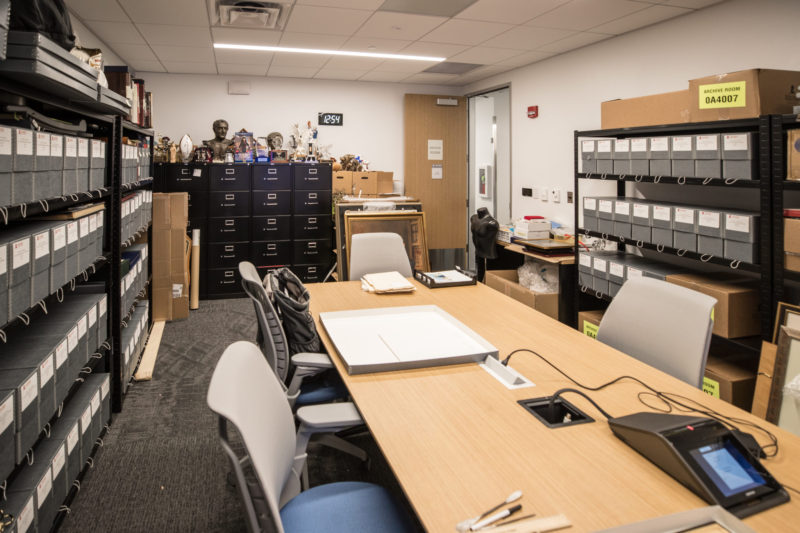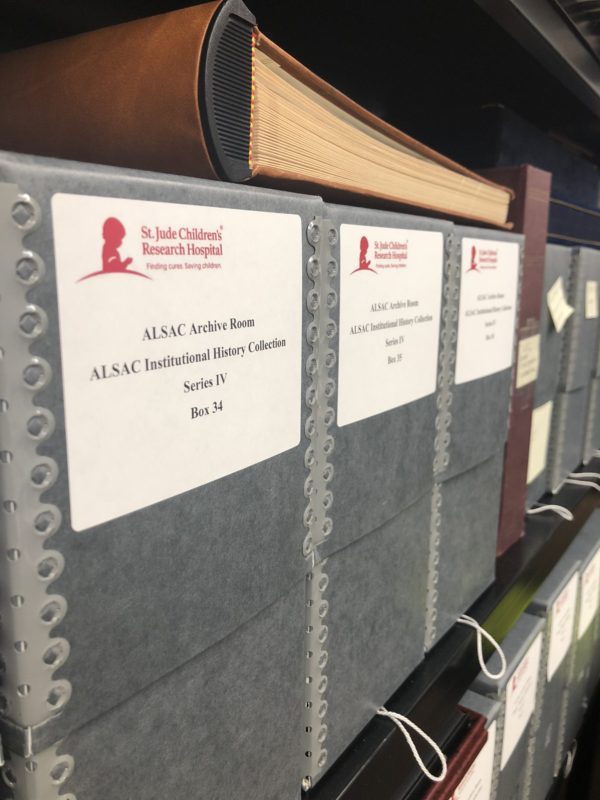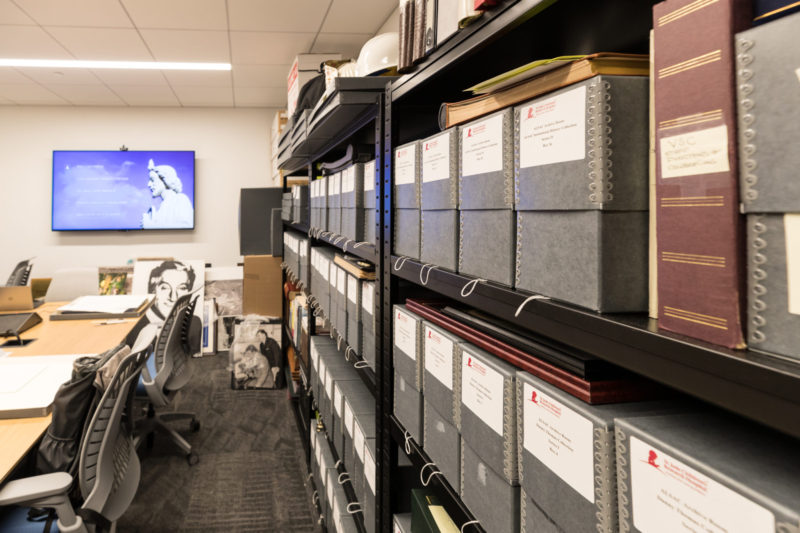Transforming the ALSAC/St. Jude Archive
21 August 2018 – Max Farley

The ALSAC/St. Jude Archive Room. Photo credit: ALSAC Photography
Last July, during the final months of a summer archival fellowship at the Memphis Public Library, my academic advisor contacted me about a public history opportunity at ALSAC/St. Jude Children’s Research Hospital. ALSAC, the fundraising and awareness organization for St. Jude, had reached out to Rhodes College asking if there were any public history students who could help them reimagine their archive space. I expressed interest, and three weeks later unlocked the archive room for the first time.
As a transplanted Memphian with casual knowledge of one of the most famous research hospitals and charities in the world, I was familiar with the stories which surrounded its founding. These stories are enshrined in the Danny Thomas/ALSAC Pavilion, a gleaming on-campus testament to ALSAC/St. Jude’s history and heritage, but its exhibits display only a handful of artifacts. When I entered their archive room, I discovered that ALSAC/St. Jude’s institutional records were much deeper and richer than these exhibits suggested.
The beauty of an institutional archive like ALSAC/St. Jude’s is found in its unique ability to strengthen the stories told by the institution that maintains it. Individuals seeking to learn more about the hospital’s history and heritage have an unparalleled chance to hear American entertainer and ALSAC/St. Jude founder Danny Thomas “speak.” They can access primary source documents which describe his plan for a research hospital that would seek to solve the then-unsolvable problem of childhood cancer. In one month of archive use alone, ALSAC/St. Jude communications writers researched Danny Thomas for an “A to Z” retrospective, national direct marketing staff accessed historic mailing samples, and an executive office speechwriter dove into the hospital’s technological history through committee meeting minutes. By providing a space for staff to engage deeply and carefully with primary sources, the ALSAC/St. Jude Archive is strengthening both institutional memory and the public’s perception of the hospital.

The ALSAC/St. Jude Institutional History Collection. Photo credit: Max Farley
At the beginning of my internship, the ALSAC/St. Jude Archive presented several opportunities for improvement. Archival boxes and other materials were in short supply, and the archive’s existing inventory was out of date. The authoritative sources for all of St. Jude’s institutional history and memory were crowded into a storage area that lacked environmental controls. A consultant brought in to assess the archive room back in 2016 had indicated that the archive room was in relatively good shape. Despite this positive assessment, I found that because there were no finding aids, locating materials was a challenge, and the archive’s records needed to be updated due to the archive’s existing role within departmental workflows. I began working soon after my first visit, starting with a dive into research regarding archival development techniques. Once I had established a framework, I began processing the massive holdings of the archive piece by piece, starting with the most vulnerable items. Processing these collections felt more like triage than historical work, but as I progressed, my confidence in the project began to increase.
Protecting the histories contained within institutional archives is too important to be a volunteer’s part-time project: archives require investment. The ALSAC/St. Jude executive office leadership have enthusiastically supported this project, and ALSAC CEO Richard Shadyac Jr. has stated that my contributions “in transforming the ALSAC Archive Room have been invaluable.” Communications staff estimate that my year of work has advanced the archive room project by about five years; evaluating the validity of this estimate would be difficult, but there’s no question that my internship has shaped the ALSAC/St. Jude Archive room into a strategic asset. When companies demonstrate a willingness to invest in their own histories, they should look to partner with and benefit from the knowledge and skills of public historians.

The ALSAC/St. Jude Archive Room. Photo credit: ALSAC Photography
I graduated from Rhodes College in one of the first groups of history majors that could concentrate their studies around public history. The ALSAC/St. Jude Archive project will continue, serving as a living demonstration of the value of protecting history and memory in the workplace. The ALSAC/St. Jude Archive proves that public history has a home in that workplace. Companies of all shapes and sizes can benefit from the skills and expertise of public historians. Furthermore, the ALSAC/St. Jude project demonstrates that archives have value as homes for institutional knowledge, and are indispensable resources. Finding ways to store and maintain this imprecise body of knowledge within fast-paced corporate environments remains a priority for many companies, and institutional archives provide an avenue to preserve not only company history writ large—materials tied to linear historical narratives, complete with mergers, leadership changes, and other concrete events—but also the institutional knowledge found in memos, thank-you notes, contact lists, meeting summaries, and other types of material minutiae. Institutional archives serve as dedicated repositories for materials of both immediate and more nuanced value, repositories that can prove invaluable for institutions seeking to better understand their own pasts as they make decisions that will influence their present and future.
~ Max Farley is the archive coordinator at ALSAC/St. Jude Children’s Research Hospital and a graduate student at Middle Tennessee State University, where he studies public history and museum management.



